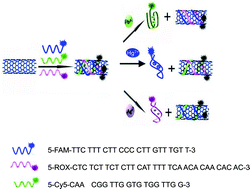Coupling nanomaterials with biomolecular recognition events represents a new direction in nanotechnology toward the development of novel molecular diagnostic tools. A novel aptamer biosensor based on multi-walled carbon nanotube (MWCNT) long-range energy transfer has been developed for sensitive, selective and multicolor fluorescent detection of Hg2+, Ag+ and Pb2+ ions in homogeneous solution. The fluorescent dye-labeled aptamer is adsorbed on MWCNTs due to their strong π–π stacking interactions, leading to quenching of fluorescence of the dye. Desorption of the dye-labeled aptamer from MWCNTs, through the specific binding of the aptamer with its target, resulted in the restoration of the fluorescence signal of the dye. Due to the non-covalent assembly between the aptamer and MWCNTs, highly efficient long-range energy transfer from the dyes to MWCNTs takes place. In the presence of metal ions, the binding between the aptamer and metal ions will disturb the interaction between the aptamer and MWCNTs, and release the dye-labeled aptamer from the MWCNTs' surface, resulting in restoration of the fluorophore's fluorescence. Importantly, the high specific surface area of MWCNTs allows the quenching of multiple aptamer probes labeled with different fluorescent dyes, leading to a multicolor nanosensor for simultaneous detection of multiple metal ions in the same solution. As a proof of concept, we demonstrated that a three-color nanosensor can rapidly and simultaneously detect three metal ions (i.e. Hg2+, Ag+ and Pb2+) in a single solution. This MWCNT-based sensing platform exhibits high sensitivity and selectivity toward Hg2+, Ag+ and Pb2+versus other metal ions, with a limit of detection of 15 nM for Hg2+, 18 nM for Ag+ and 20 nM for Pb2+.


 Please wait while we load your content...
Please wait while we load your content...